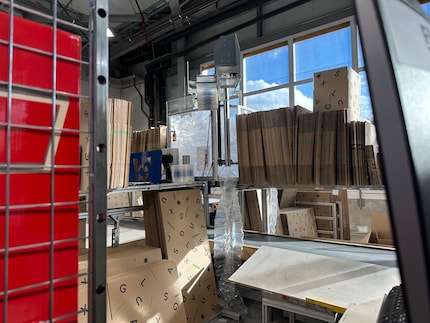
Company news
SBTi: achieving net zero CO2 emissions under scientific supervision
by Tobias Billeter

Many of our customers – and you might be one of them – are annoyed with the plastic air pillows that we use to prevent their orders from being damaged. Alternatives include cardboard bits, crumpled paper and cornstarch packing chips. But our plastic filler air pillows still come out ahead.
Recently, we started using new cardboard boxes for our shipments. As a result, we’ve been able to cut back the amount of air that we ship by an average of 28 per cent per hand-packaged parcel. In doing so, we’re also minimising the mountains of plastic air pillows that get popped or slashed open, only to end up in a trash can or recycling bin. For small package sizes, we can now typically omit them altogether.
But we can’t go completely without filler materials; your products would clomp around unprotected in the parcels, which would also lead to them getting dents and holes more easily.
There are, however, alternatives to plastic – alternatives that may initially make a greener impression. But are they really better both for us humans and the environment? Here’s the short answer: our solution is not only cheaper, it’s also less harmful to the planet.
Let’s take a closer look at the alternatives and their advantages and disadvantages. First up is what’s probably the most obvious option: cardboard or crumpled paper. There are two classic form options here, namely shreds or cushions. The former come from shredders, the latter from special machines that slit the cardboard longitudinally (here’s an example).
First off, the advantages of cardboard or paper as a stuffing material: trees grow back and bind CO2; recycling in Switzerland is easy and a given in most places. The downside? Production of paper and cardboard require a lot of energy and water. According to specialists from the German packaging materials manufacturer ActivaTec, producing one kilo of paper, for example, requires 24 times more water than one kilo of plastic.
What’s more, plastic air pillows are significantly lighter. According to ActivaTec, while air pillows are 99 per cent air and only 1 per cent material, the ratio for crumpled paper is 20 per cent air to 80 per cent material. As a result, less waste emissions are produced during transport. Migros supermarkets (link in German) also rely on plastic for cereal and muesli packaging, for example, because it weighs less.
By the way, like cardboard, plastic air pillows can be recycled. Unfortunately, there aren’t yet comprehensive collection points for them in Switzerland.
Cardboard cushions would make sense if they were made from scraps. But Digitec Galaxus’ warehouses don’t generate nearly enough cardboard waste for this. We’d have to buy extra cardboard to use as stuffing material. Every day, around 30 Post trucks leave our Swiss warehouse in Wohlen, filled to the rafters. If we stuffed our packages with cardboard, we’d need about ten trucks a day to deliver the shreds or cushions to us. The rolls of thin plastic film that we fill with air at the packing stations are more space saving and lighter.

The same applies to cornstarch chips – the modern version of Styrofoam chips. Cornstarch chips take up even more space in trucks and warehouses than paper or cardboard; this worsens their environmental footprint and makes them impractical for large logistics operations. Ten rolls of air pillow film are equivalent to a whole truck full of cornstarch chips for us.
What’s more, cornstarch chips are often disposed of incorrectly – be it because there’s no compost or green waste collection available, or because some people are unaware of the water disposal trick or simply stuff the chips into the normal trash, as they don’t know any better.
Compostable air pillows made of so-called polylactic acid are another option that’s also derived from corn. Such padding would even be available from Airplus, which is the brand we already rely on. However, the additional costs are disproportionate to the amount of greenhouse gases saved. Specifically, the organic rolls cost 12 per cent more, but they’d only save 15 per cent of CO2 on the bottom line. Side note: Since the beginning of 2022, Digitec Galaxus has offset 100 per cent of its operational climate footprint – packaging materials included.
We believe our entire range of products should arrive at your doorstep in prime condition. That’s why we protect your products as much as is necessary, but as sparingly as possible. By now, we also have four machines that package orders entirely without filler material. By the way, if you carefully tear open these boxes on the perforated side, you can easily reuse them. On the other hand, fragile items, liquids or orders that weigh more than 13 kilos in total are always packed by hand.
We also ship smaller items such as cell phone charging cables without filler material. These fit into envelopes – and postage is cheaper to boot. We also put clothing in resealable plastic bags. And for products like diapers or air conditioners, which are already packaged sturdily enough, we just stick on the shipping label directly.
As you can see, we’ve put plenty of thought into how we ship your order. Of course, that’s not to say we’ve got it all figured out. If you do have any constructive criticism or ideas, please let us know in the comments.
At Digitec and Galaxus, I’m in charge of communication with journalists and bloggers. Good stories are my passion – I am always up to date.
News about features in our shop, information from marketing and logistics, and much more.
Show all